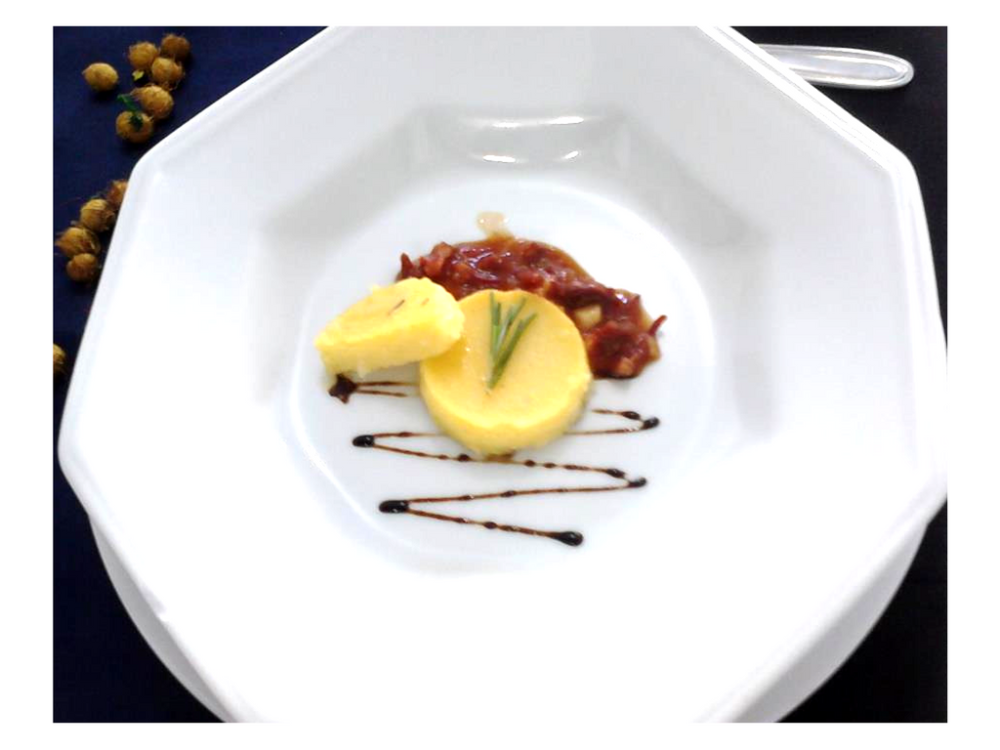
Traditional Brazilian Appetizer to bring exquisite recipes to your fine dining table for special ocacsions.
INGREDIENTS
The Ragu Dry Meat
400g of dried meat or desalted salt;
1/2 medium onion chopped in the smallest possible size (brunoise);
2 cloves garlic, minced in the smallest possible size (brunoise);
3 tablespoons olive oil;
0,3l of white or red wine;
500ml of water;
Pelati 1 can of tomatoes into cubes or 3 Italian tomatoes, seeded and peeled;
Salt to taste, if necessary after completion of Ragu
The polenta
200g of fine corn flour for polenta;
700ml of water (to dilute the polenta);
½ teaspoon salt tea;
PREPARATION
Ragu Dry Meat
1. Before any procedure, dessalgue their dried meat, which usually comes to us consumers with too much salt to your saves. Cut the meat into large cubes of edge 5cm +/- each. Dip these cubes of dried meat in a container with water to the surface of the meat, covering the cubes. Keep this container in the refrigerator and replace your water every 2 hours, 3 to 4 times depending on how their meat is salty.
2. To find out if your meat is too much or too little salt, just testing the water at the last and penultimate exchanges; if it is too salty, require more exchanges of cold water, if the water is only brackish, will be ready the meat to be manipulated.
3. In a pressure cooker and over medium heat, saute onion and garlic in olive oil, leaving them brown. Add to this mixture the meat without water dessalgue, in order to seal (browning meat outside), while stirring occasionally.
4. Add the wine, water and cover the pressure cooker, sealing it well. Lower the heat to the lowest setting and cook in pressure for about 30 minutes.
5. Turn off the heat, allow the pressure out completely. Open the pot and see if the meat is well tender, otherwise return it to the fire, with the covered pot for a few minutes (10minutes, depending on how the meat in question is still hard).
6. Once cooked meat and tender, remove all the liquid that came off the meat into another container and set aside.
7. Close the pressure cooker with the meat cooked inside, and shake several times and vigorously. When you open the pressure cooker meat should be shredded completely. If not, close the pot again and repeat the procedure until the desired result.
8. Transfer the meat with its broth to a small saucepan and deep, add pelati tomatoes, mix well, correct the salt if necessary, and leave on medium heat until the broth begins to reduce and refine. About 20 minutes. The more reduce broth, the flavor will be determined.
Polenta
Boil water in a deep pan and add low-temperature salt and fine corn flour gradually, stirring until it is full-bodied and creamy. Preferably, follow the "proportion" of water and cornmeal, and the "method of preparation" of the flour manufacturer to polenta to buy, after all there are differences in the composition of each of these industrialized corn mixtures! Porcione container or format you want to serve.

About Me
In 2012 I began my cooking journey in Brasil and studied at “Senac, Juiz de Fora”, in Minas Gerais, developing my basic culinary techniques.
Later I worked in a local restaurant, and rose to a role in management, helping to increase the clientele base. I then discovered a refined bistro called “Assunta” in Minas Gerais and cooked as a Chef de parti. In this place I became sure of what I wanted for my life. Learning an important chef’s culinary art at that time aroused my desire to live abroad; learn English and improve my culinary techniques.
Following this experience I traveled to Ireland in Europe and began working in an Irish restaurant as a Kitchen Porter and later working as a Chef de Parti.
Having met my girlfriend, I embarked on the third part of journey to Thailand in 2014 where I gained an Asian cooking experience and improved my International culinary techniques. In Bangkok I had the privilege of undertaking a course in one of the most prestigious international networks of French cuisine; “Le Cordon Bleu”.
Having completed the Advanced cooking level there I traveled to Italy and learnt more about Mediterranean cooking and then returned to Brasil, where I’m now based.

Chef Recipes Site
Chef Recipes Shop
Blog Post
Recipe Site
